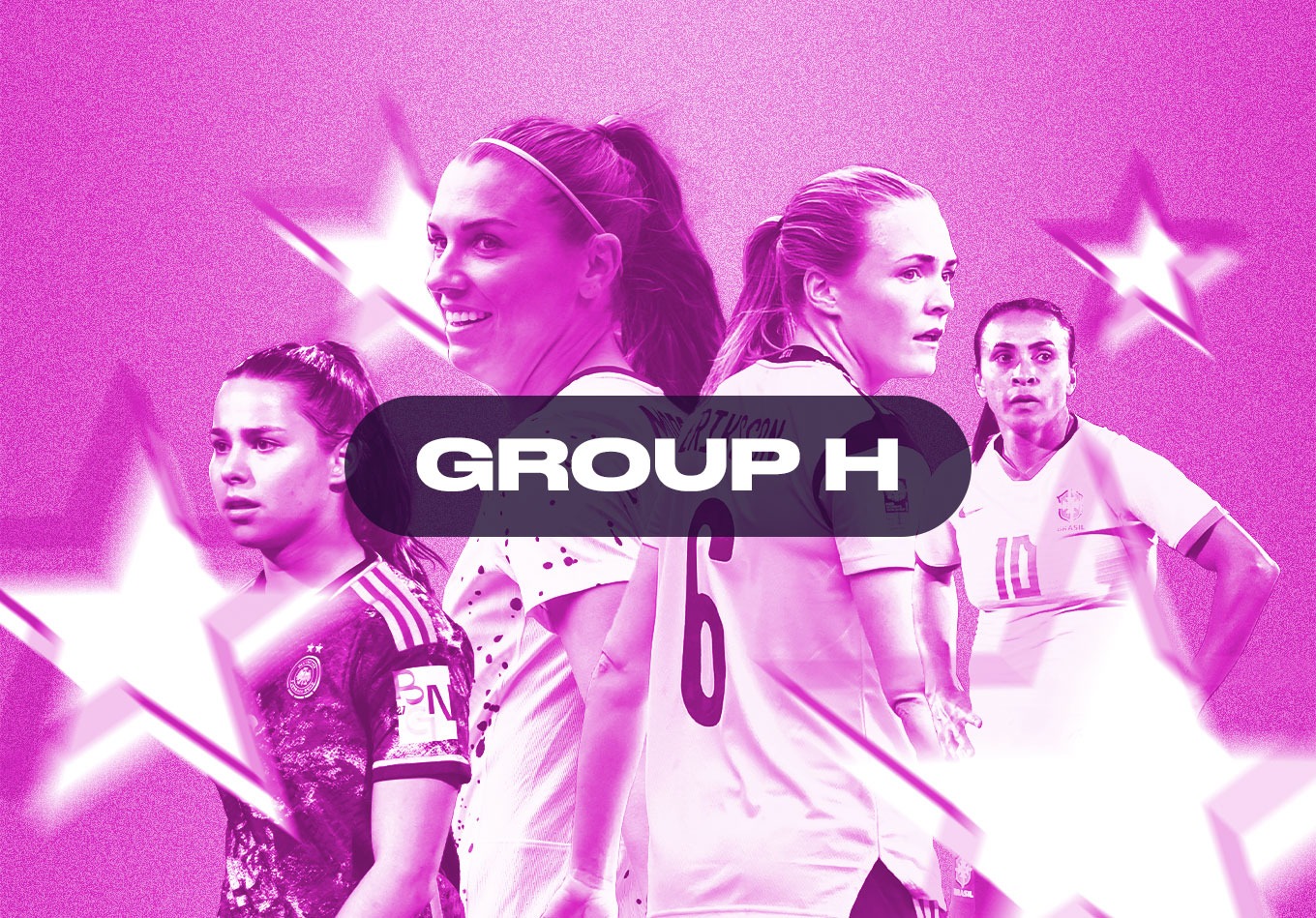Things are about to get heated – or chilly, meteorologically speaking – down under as teams prepare for the ninth edition of the Women’s World Cup. The favourites, the underdogs, the dark horses are all running the same track for women’s football’s most-coveted prize.
Group H has a clear favourite in Germany, but the other three nations have all gone close to glory in recent times, meaning a fiercely contested first round could be on the cards here.
Germany
Pedigree
The two-time World Cup winners are an indomitable force in international football. The No.2 ranked nation, according to FIFA, are being trumpeted as one of the likeliest to go all the way in Australia and New Zealand.
The Germans have featured in every single edition of the Women’s World Cup since its inception in 1991. After becoming the first nation to successfully defend their crown in 2007, Germany are eager to add a third star to their badge.
However, Germany’s slightly poor run of results in 2023 has raised questions of head coach Martina Voss-Tecklenburg. They’ve been defeated twice and held to a draw once in their five games this year.
A recent stoppage-time loss to Zambia in the lead up to the World Cup has concerned supporters, but Germany are notorious for underwhelming in preparatory games before excelling at major tournaments.
Remember the 3-2 loss to Serbia before the UEFA Women’s Euro 2022 last year? This was also the only loss they endured in their World Cup qualification campaign.
The 2022 Euros runners-up finished top in qualifying with a record of nine wins and one loss in 10 games, scoring a whopping 47 goals, highlighting a real proficiency in front of goal. Not that this is anything new for them; after all, Germany (121) and the United States (138) are the only nations to score 100 or more goals at the Women’s World Cup.
In fact, two Germans feature among the Women’s World Cup’s top five all-time leading scorers. Legendary forward, Brigit Prinz (14), is second only to Marta (17), while Bettina Wiegmann is one of three players tied in fifth on 11.
The current squad boasts some prolific goalscorers as well, however.
Schrödinger’s Striker
Germany’s striker position is an interesting conundrum. In Lea Schüller and Alexandra Popp, Voss-Tecklenburg has two very able players to choose from.
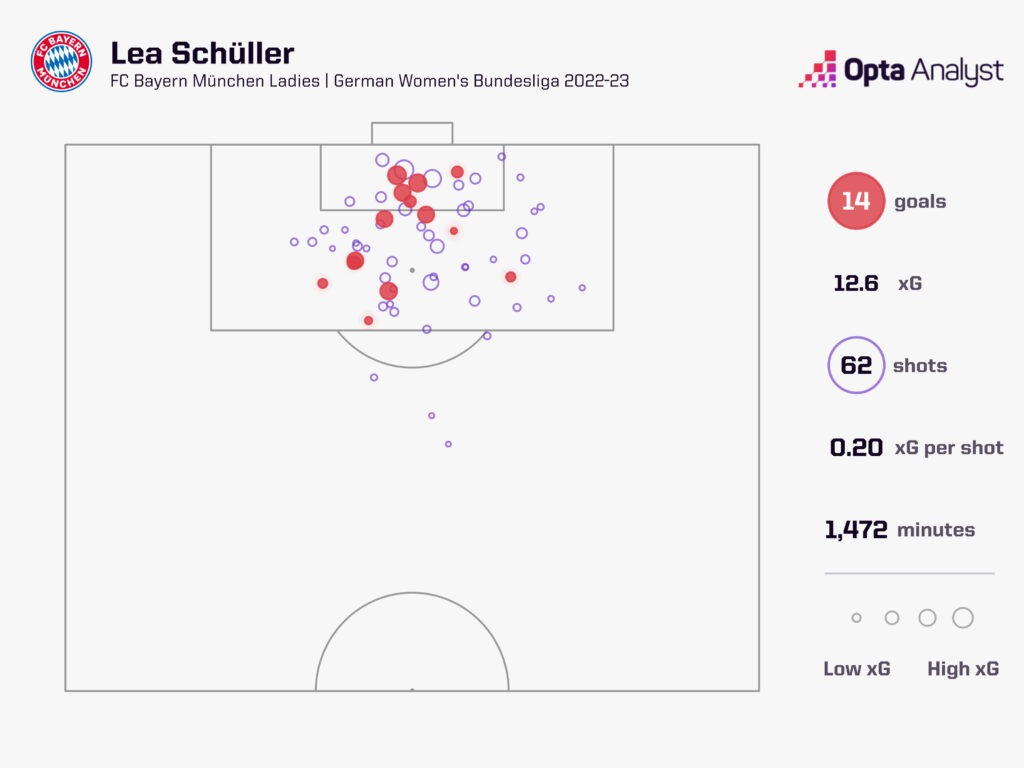
Bayern Munich’s 25-year-old forward, Schüller, is coming off the back of a 14-goal domestic season with the Bavarians. She finished as the joint-second top scorer, averaging 0.86 goals per 90 minutes. She is consistently able to get into good shooting positions, as highlighted by her average shot quality in the league.
Among players with more than 25 shots, Schüller had the highest average expected goals (xG) value per attempt (excluding penalties) of 0.20 in the Frauen Bundesliga. She also gets plenty of shots away, averaging 3.8 per 90 in the league, behind only Ewa Pajor (5.6). Schüller possesses excellent predatory instincts and awareness inside the box, constantly looking to orient herself towards goal.
The former Essen striker was the second top scorer during the World Cup qualification campaign with 15 goals, just behind Belgium’s Tessa Wullaert (17).
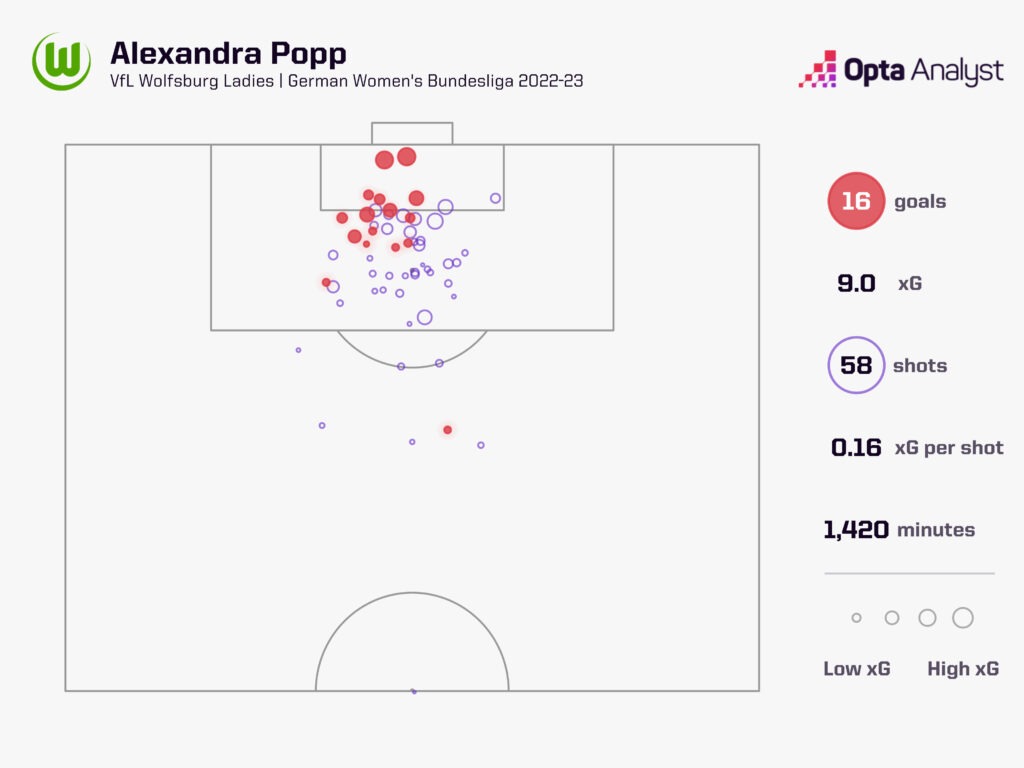
But the experienced Popp, who was the joint-top scorer at the Euros last year with six, is also competing for a spot. The veteran enjoyed a very fruitful campaign in the Bundesliga, with her tally of 16 goals more than anyone else. The 32-year-old averaged a goal every 3.6 shots and was incredibly efficient in converting her chances; no player had a higher over-performance on their non-penalty expected goals (npxG) than Popp (+7.0).
The physically imposing and intense presence of Popp is even more valuable in knockout scenarios, when she can swing the game and score goals from dead-ball situations with her aerial ability. Her 68.7% aerial duels success rate was the fifth highest in the Frauen Bundesliga last term, potentially giving Germany an added edge over their opponents.
Schüller has got the nod when both have been fit, but it remains to be seen if Voss-Tecklenburg will throw us any more curveballs, like playing Svenja Huth at right-back against Zambia in the lead up to the tournament.
Either way, Germany have a good problem in the striker position with two very capable goalscorers, each offering different qualities on the pitch.
Young Brigade
Germany’s talent pipeline has produced some of the finest players in recent generations, and they are not slowing down. After shifting their focus to youth development, the Germans are reaping the rewards.
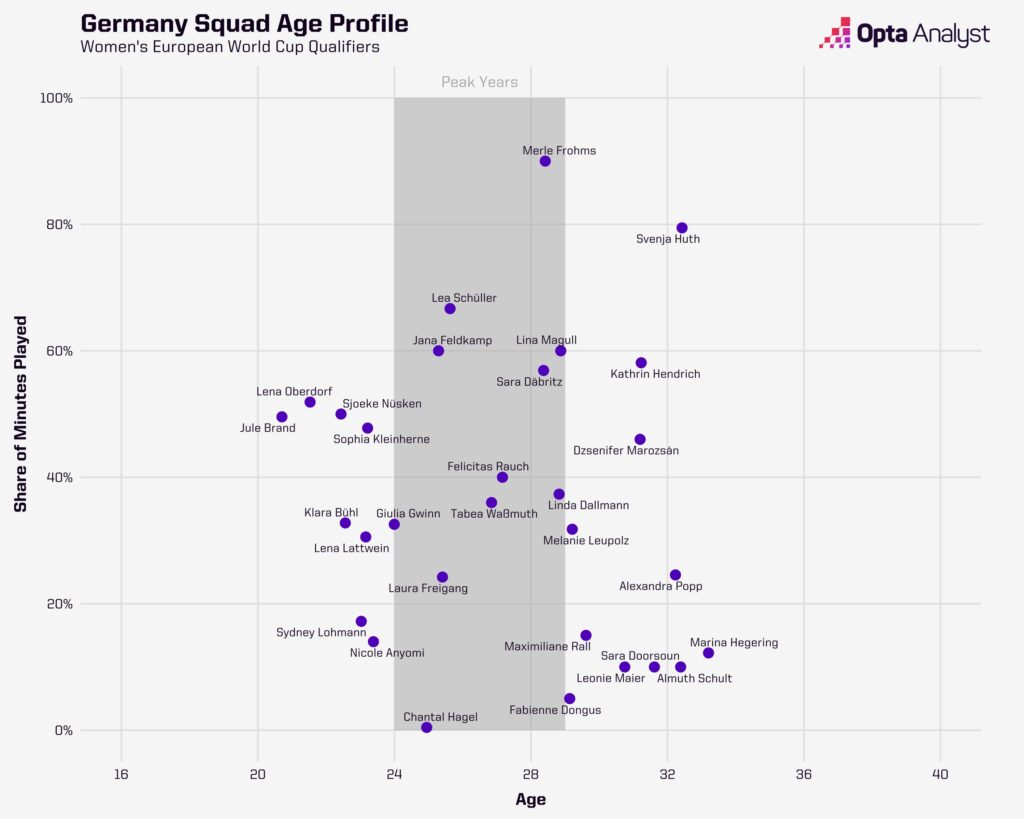
They have a team set up for success in the current cycle as well as the future with a core of Lena Oberdorf, Jule Brand, Klara Bühl, Sophia Kleinherne, Sjoeke Nüsken and Schüller all 25 or younger. The German squad has an average age of just over 26 years, with an excellent blend of talented youngsters and proven winners.
Defensive Dilemmas
With injuries to Giulia Gwinn and Carolin Simon, the German backline has places up for grabs. While Felicitas Rauch will deputise at left-back after Simon suffered an ACL rupture in their last friendly, the right-back position is much more open.
Wolfsburg’s Kathrin Hendrich has experience playing the position at club level despite being a centre-back, and Voss-Tecklenburg has previously used Kleinherne in that role. They look like the most straightforward options for the Euro 2022 runners-up, but the coach sprung a surprise against Zambia by playing veteran attacker Huth there.
Questions have been raised of their defence, with Germany unable to keep a clean sheet in any of their past three games.
It’s an area that appears a little less stacked than the other two departments in Germany’s 4-3-3, but there is no shortage of quality throughout the squad.
South Korea
On the Up?
The Women’s Asian Cup runners-up are the next-best ranked (17th) side in the group, according to FIFA rankings. They are making their fourth appearance at the Women’s World Cup and third in a row. Their 2019 campaign left a lot to be desired, though, as they were eliminated in the group stage without picking up a point.
Their record at World Cups in general is poor, being put up against at least one of Norway, France and Brazil in each of their previous three appearances. They’ve conceded multiple goals in eight of their 10 games at the tournament and failed to score in six.
South Korea defeated World Cup co-hosts Australia last year en route to their maiden Asian Cup final, which earned them a ticket to the World Cup. They even led by two goals at half-time in the final but showcased an inability to control the game in the second half, conceding three times as China clinched glory late on.
Colin Bell’s side are on a run of three straight wins coming into the tournament, beating World Cup debutants Zambia (twice) and Haiti. They participated in the Arnold Clark Cup at the start of 2023 but couldn’t manage a win despite pushing Belgium and Italy all the way, suffering a pair of 2-1 defeats.
Nevertheless, Bell’s side have proven an ability to be solid at the back while letting their difference-makers do the job in the final third. Their 3-4-2-1 is geared towards defending in numbers and being defensively sound, but they do lack the numbers in midfield to offer them control. The attack largely looks to the brilliance of the likes of Ji So-yun and Lee Geum-min.
Stars To Look Up To
South Korea will once again look to all-time leading goalscorer Ji to deliver the goods in attack. The former Chelsea player has made the joint-most appearances for the national team (145, tied with Cho So-hyun), scoring a record 67 goals.
She is widely regarded as one of the finest foreign players in Women’s Super League (WSL) history, having spent eight years with Chelsea after joining them in 2014. She won six league titles and the Women’s FA Cup four times during her time in England.
The diminutive midfielder is a magician on the ball and can impact games by scoring and creating equally well. She has set-piece mastery in her repertoire as well, making her a threat in open play and at dead-ball situations. That technical brilliance shines through in her long-range shooting too, with this varied skillset making her dangerous all over the attacking half.
Only Australia’s Sam Kerr (7) scored more goals than Ji (5, tied with 4 others) during the 2022 AFC Women’s Asian Cup. The South Korea star converted five of her six shots on target, including a late winner against the Matildas in the quarter-finals.
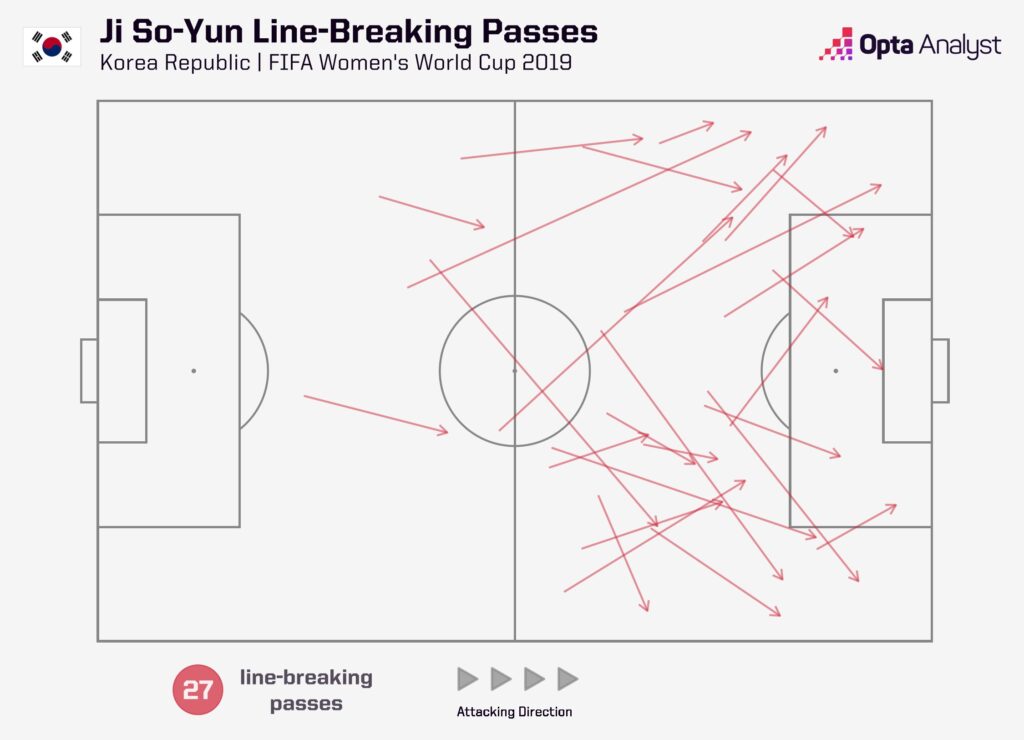
But beyond being a goal threat, Ji is blessed with excellent vision along with the weight and timing on her passes, making her capable of threading the needle in crowded areas. During the 2019 Women’s World Cup, Ji made nine passes that broke through the opponent’s defensive line, and six passes that broke through a line and found a teammate in the penalty area.
No player in the tournament managed to find a teammate in the area more often with a line-breaking pass than the South Korea star, despite them exiting at the group stage.
Another key player in the South Korea setup is Brighton forward Lee. While not the most prolific goalscorer, the former Manchester City player shines through her incredible link-up play. She likes to get on the ball and play lay-offs, acting as a conduit between the lines.
Lee has been sharp in front of goal this year, though, netting five times in her past three outings for South Korea. Usually deployed as one of the 10s or as the striker, she will be key to the team’s hopes of making this a memorable tournament.
Colombia
Reasons for Optimism
Colombia will be making their third appearance at the Women’s World Cup, returning to the global stage after missing out four years ago. They were up against France, Mexico and England in their previous appearance back in 2015, managing to score in each of their three group games and earning their only win in World Cup history (against France) to reach the knockout stages in third.
Nelson Abadía’s side are coming into this World Cup with a mixed bag of results. Last year was generally positive, losing only once – the Copa América Femenina final to Brazil – between the start of July and the end of 2022. This year, they’ve scored in all of the seven matches they’ve played, but only two have ended in victory.
That run to the Copa América Femenina final was their third silver medal in the last four editions of the competition. They had an unblemished record before that game, winning all five games en route to the showpiece.
Team Liga F
Colombia have some recognisable names who are lighting up the Spanish league. Manuela Vanegas (Real Sociedad), Mayra Ramírez (Levante), Leicy Santos (Atlético Madrid) and Linda Caicedo (Real Madrid) all ply their trade in Liga F and will be key in the side’s hopes of progressing out of the group stage.
The trio of Ramírez, Vanegas and Caicedo were among Colombia’s five joint-top scorers at the Copa América Femenina, with two goals each.
Vanegas has been vital to Real Sociedad’s build-up and is an important ball-player for the side when trying to retain and recycle possession. Only Mapi León (1,950) attempted more passes than the Colombian defender (1,838) in Liga F.
Ramírez arrives at the World Cup on the back of a spectacular domestic season, helping Levante secure a place in the UEFA Women’s Champions League qualifiers. She was one of the two players in Liga F to reach double digits in both goals (14) and assists (11).
Her tally of 25 goal involvements saw her rank fourth for such contributions, while her 11 assists was only bettered by Caroline Weir and Nerea Eizagirre (both 12).
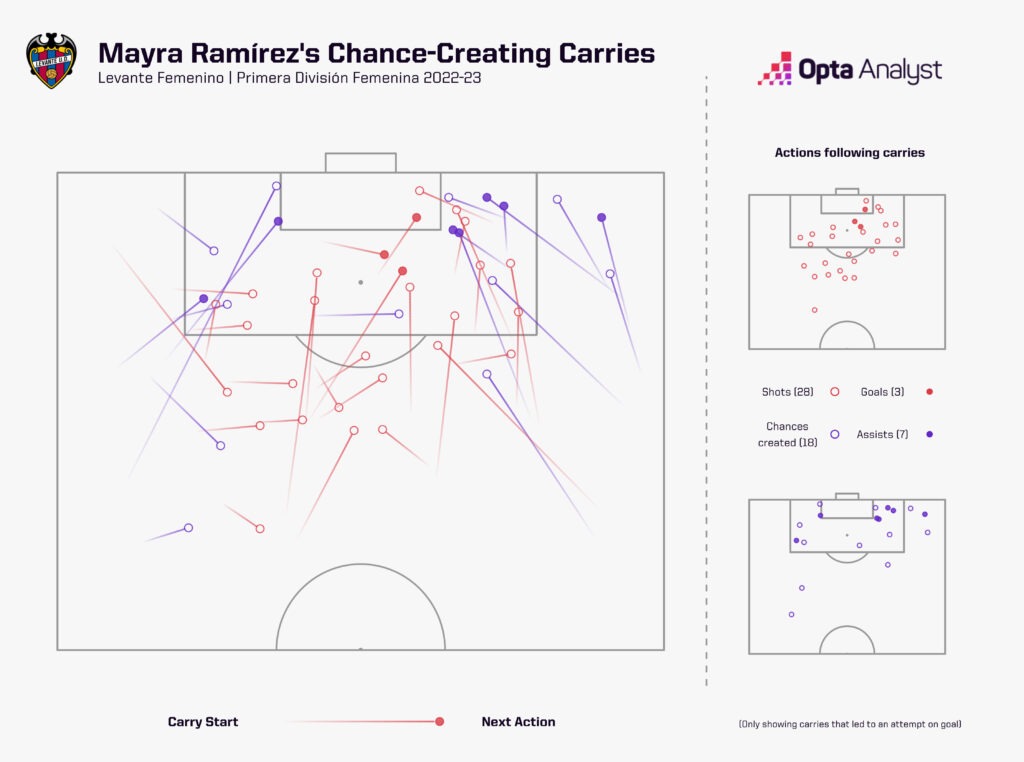
Part of what makes the 24-year-old so impressive is her purpose and positivity on the ball. She ranked second among Liga F forwards for progressive carries (192), while only Racheal Kundananji (75) registered more carries that ended in a shot or chance created than Ramírez (46). But in terms of carries leading to an assist, no one bettered her seven. She showcases incredible balance when running with the ball, allowing her to ride contact and provide penetration into dangerous areas.
As for the next generation of Colombian talent, 18-year-old Real Madrid winger Caicedo is a beacon of light. The youngster moved to Spain after her 18th birthday in February and, despite playing just 678 minutes for her new club, she finished the season as the fourth-highest assist provider (four) in the squad, also averaging the best assists per-90 figure (0.53).
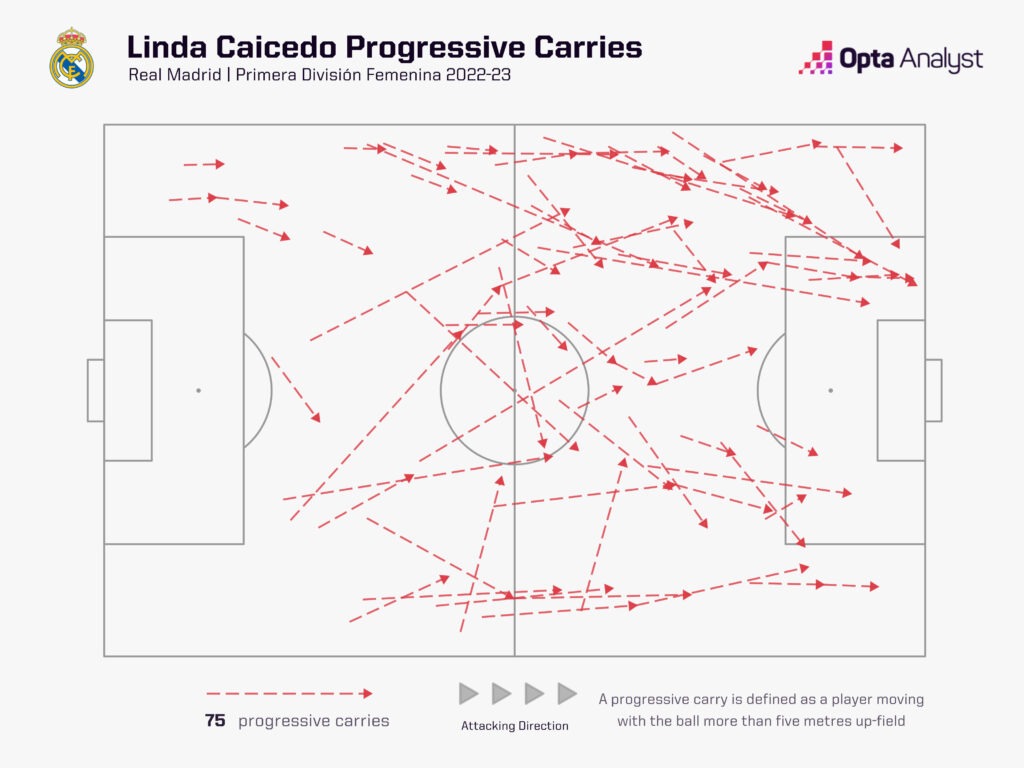
The youngster is also an excellent ball carrier, with her 9.96 progressive carries per 90 being the second most in Real Madrid’s squad (minimum 19 minutes played). She is very economical with her touches and uses her frame well to shield possession, making her secure as well as progressive on the ball.
She often operates in a free role in the Colombia side, commonly drifting inside from a wide-left position and working from the half-spaces or central areas. She shows a great understanding for combination and link-up play in the final third and is explosive with tidy footwork in one-v-one situations, making her an excellent operator in tight spaces.
Her 5.2 attempted take-ons per 90 was second only to Athenea del Castillo in the Real Madrid squad, and despite those dribbles largely coming in the final third of the pitch, she boasts a success rate of 56.4%, evidence of her tremendous technical ability. She will be key in Colombia’s offensive mechanics.
Morocco
The Underdogs
Morocco are the second-lowest-ranked nation (72) at this World Cup and are one of the eight debutants. They are also the first Arab country to qualify for the FIFA Women’s World Cup.
Their World Cup ticket was secured via a historic campaign in the Women’s African Cup of Nations (WAFCON) on home soil last year. They finished as runners-up at the tournament, losing to South Africa in the final. The country has seen a massive boost in its women’s footballing structure in recent years and they are slowly reaping the rewards.
Morocco averaged the most possession (60.2%) and the best passing accuracy (79.5%) during the 2022 WAFCON, but it’s unlikely they will have a monopoly on the ball at the World Cup.
Big-game Know-how
Morocco are led by former Olympique Lyonnais Fémenin head coach Reynald Pedros. The two-time UWCL winning manager has tweaked his approach in the lead up to the World Cup, looking more likely to adopt a pragmatic 4-4-2 over their usual 4-3-3.
They earned back-to-back 0-0 draws against Switzerland and Italy earlier this month; those results arguably flattered them a little, though, as Morocco continue to give up quality chances.
Shoring up the defence might still be their best bet going into the tournament. However, this puts extra pressure on their star forward…
Leading From the Front
Rosella Ayane scored the winning penalty against Nigeria in the semi-final of the WAFCON and etched her name in Moroccan women’s football folklore forever.
The versatile Tottenham forward is the lynchpin in attack for Morocco. She is capable of playing across the frontline but will probably be tasked with operating centrally at the World Cup. Born in Reading, Ayane decided to play for Morocco two years ago, having represented England at youth level. The 27-year-old has since scored nine in 21 appearances for her adopted country.
Goalscoring will be her main agenda with the national team, unlike at club level where she is expected to create chances from the flanks using her crossing and vision. Released by Chelsea in 2016, Ayane has gone on to hone her skills and become a well-rounded forward who is adept at creating and scoring with either foot.
She can stretch the field with her positioning and show up between lines as an outlet while remaining a threatening option in behind. For Morocco, a lot will rely on her effectiveness on and off the ball in the final third.
Another key player for Pedros’ side will be Ghizlane Chebbak. She was involved in the joint-most goals during the 2022 WAFCON (3 goals, 1 assist – level with Nigeria’s Rasheedat Ajibade). Chebbak also made at least 91 more successful passes than any other player in that tournament (337) and created the most chances (17).
It’s going to be a Herculean undertaking for Morocco to pull off a result against European giants Germany, but they could threaten either of the other competing nations in the group.
Enjoy this? Subscribe to our mailing list to receive exclusive weekly content. And follow us on Twitter too.
